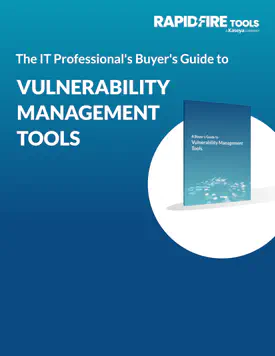So, you know what vulnerabilities are and that vulnerability scanning can help mitigate those vulnerabilities. Now you need to establish your own vulnerability management program. But what are the main elements of a vulnerability management process? While every organization takes a different approach to its vulnerability management process, it largely revolves around three main elements or phases.
Skipping any of these renders your entire process incomplete and ineffective.
- Identifying vulnerabilities: This step usually involves a vulnerability scan that identifies a variety of systems on a network and probes them for different attributes — operating system, open ports, installed software, file system structure, and more. The results are delivered in the form of reports, metrics, and/or dashboards.
- Evaluating vulnerabilities: After identifying the vulnerabilities, the next step is to evaluate them to assign different risk ratings and scores to determine the priority of each vulnerability. A few questions that to consider while evaluating each vulnerability include:
- Is the vulnerability a true or false positive?
- Could the vulnerability be directly exploited from the internet?
- How difficult or easy would it be to exploit the vulnerability?
- What would be the potential impact on the organization if the vulnerability is exploited?
- Do any security controls already exist to protect the vulnerability from being exploited? f. For how long has the vulnerability existed on the network?
- Treating Vulnerabilities: Once a vulnerability has been evaluated and validated, an organization must decide how it should be treated by involving the relevant stakeholders. The ways to treat vulnerabilities include:
- Remediation: Deemed as the ideal treatment of a vulnerability, remediation involves fully fixing or patching the vulnerability so that it can’t be exploited.
- Mitigation: Organizations can opt for mitigation when a proper fix or patch isn’t yet available for the vulnerability. This method will reduce the likelihood and/or impact of a vulnerability being exploited, buying an organization time to eventually remediate the vulnerability.
- Acceptance: Organizations can also decide neither to fix the vulnerability nor reduce its likelihood/impact. This is justified when the vulnerability is considered low risk and the cost of fixing it is greater than the potential cost the organization would incur if exploited. You must know the requirements of your cyber insurance policies, contracts, and regulations before deciding to leave a vulnerability unfixed.
While this process can seem daunting, there are solutions that can help you manage and automate many tasks associated with vulnerability management. VulScan is a vulnerability management platform designed to help you deliver Vulnerability Management services. It includes all the key features and functions you need, without the unnecessary bells and whistles that add complexity and cost.
Get a demo of VulScan and see how it puts you in the ideal position to deliver Vulnerability Management and reduce your risks.
